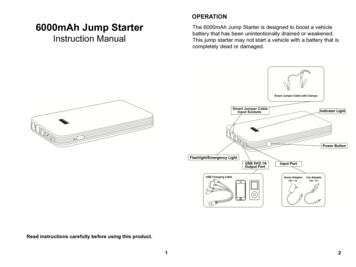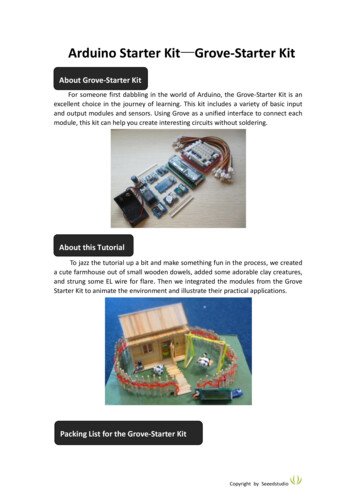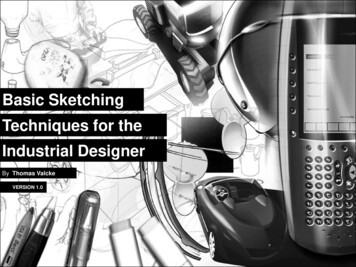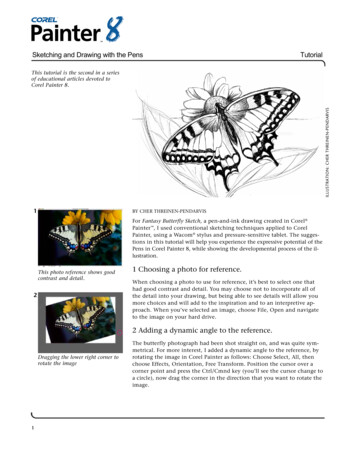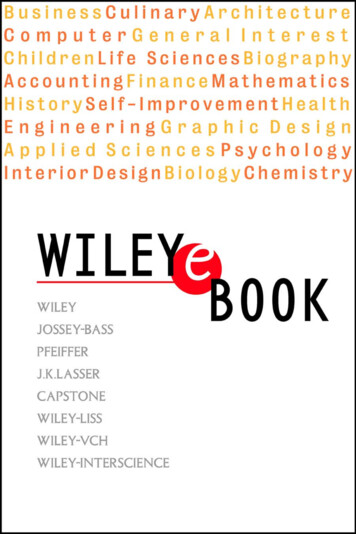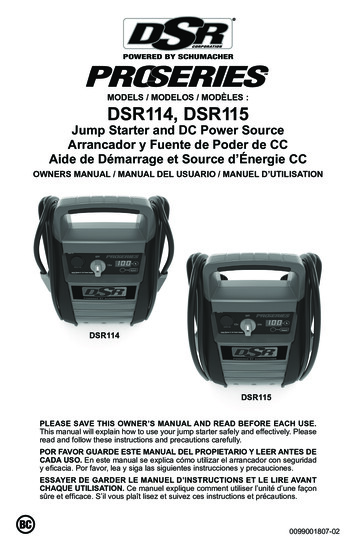
Transcription
07/09/2014TechnologyLesson Starter Exercises – Sketching Focus‘Developing Student’s Sketching & Communication Ability’1
07/09/2014Lesson Starter Exercises - Resource Pack ObjectiveStarter exercises can be used at the beginning of technology lessonsto engage students and to promote design related discussions. Theshort exercises can form a routine start to lessons with an overallobjective being, to enhance student’s verbal and sketchingcommunication. They are designed to take 10-15 minutes and canbe adapted to suit a wide range of design abilities.Lesson Starter Exercises – Content of Pack1. Generation of Ideas:Through sketching and discussion, this exercisedevelops student’s experience with products and theirunderstanding of target markets2. Product Design Focus:Looking at alternative uses to standard products3. Design Specifications:Developing student’s problem solving skills through anunderstanding of design specifications4. Design Awareness:Research Marc Newson and Development of Sketching5. Design Inspiration:Exploring how to use research and inspiration tocreate Design Solutions6. Design Inspiration to Ideas:Using resource material to creating a range of Lightingdesigns7. Product Description:Exercises designed to promote higher order thinkingwhen describing design ideas.8. Design Development:Exercise focused on design development and thestudent’s sketching and annotation ability9. Sketching & Rendering:Explores a range of sketching and renderingtechniques, equipment needed and template exercises.10. Questionable Product Design: Exploring the social and moral responsibility of theDesigner, through group discussion.2
07/09/2014Lesson Starter Exercises – 1. Generation of IdeasOpening QuestionAll the toothbrushes in the image above perform the same task. Why then are they all different?As a designer, think about your own toothbrush, what is it that you find appealing about theproduct and what aspects you would like to change.Lesson Starter Exercises – 1. Generation of IdeasIntroduction:Students are often unaware as to the presence of design and the impact of design ontheir lives. Use the opening question to highlight to students that they are constantlydesigning and problem solving to enhance their lives and their experience with products.Task:Students are asked to sketch a range of toothbrush design ideas to a definedspecification. The specification changes every five minutes and focuses on a differentuser group. Students can use PowerPoint images as reference or if possible ask studentsto bring their own toothbrush into the lesson. This introduces a kinesthetic aspect to thetask and promotes discussion.Example Specifications Toothbrush design for the elderly Toothbrush that can be free standing on the bathroom shelf Toothbrush that can be folded or disassembled for Travel Toothbrush designed for Children to encourage them to brush for a longer period.Resources:Visual of Toothbrush DesignsVisual of ergonomics of toothbrush designVisual of Student Sketch Design Ideas*This exercise is adaptable to a wide variety of objects. Choose something that is easilyattainable and that students have experience using. *3
07/09/2014Lesson Starter Exercises – 1. Visual Resource MaterialLesson Starter Exercises – 1. Visual Resource MaterialFocus on Ergonomics & Anthropometrics4
07/09/2014Lesson Starter Exercises – 1. Student’ Design VariationsLesson Starter Exercises – 1. Student’ Design Variations5
07/09/2014Lesson Starter Exercises – 2. Product Design FocusWhat do you think this object is?What else could the object be used for?If you were to redesign this object draw or list someweird and wonderful features, it might have?Lesson Starter Exercises – 2. Product Design FocusIntroduction:This exercise is designed to develop student’s creative thought and imagination.It encourages abstract thought and expression. Through the use of iconic productdesign examples, the exercise also introduces students to developments in theDesign and Technology fields.Task:Students are introduced to a product but told nothing as to it’s function andtarget market. The objective is to decide what they think the product is and tosuggest alternative uses. The second section asks student to sketch a range ofdesign modifications and features which, enhance the design.*Define the specification so that the modified product must be commerciallyviable. This omits low level responses where students present unattainablesolutions *Resources:TR: Link to 5 additional PowerPoint exercisesVisual of Student’s sketch ideasVisual of Student’s Product Description6
07/09/2014Lesson Starter Exercises – 2. Product Design FocusHigh Level ResponseLow Level ResponseLesson Starter Exercises – 2. Product Design FocusTR: Product Design Focus Exercises7
07/09/2014Lesson Starter Exercises – 3. Design SpecificationLesson Starter Exercises – 3. Design SpecificationsIntroduction:The objective of this task is to introduce students to a Design Brief and DesignSpecifications. Through this, the task develops student’s problem solving andanalytical thinking skills. It provides students with an alternative method ofgenerating design ideas, apart from sketching.Task:Students are given a design situation and design brief, detailing the userrequirement and market trends. They are then asked to create a detailed designspecification, listing the Essential Criteria and the Desirable Criteria. Students areencouraged to sketch alongside the specification if they think of an interestingdesign solution.Extension Exercise – Students to subdivide the specifications into the User’srequirements, the Retailers and the Manufactures, each one focused on theirindividual needs.Resources:Example Design Brief and SpecificationDefinition of Design SpecificationsVisual of Student’s WorkAdditional Design Specification Task8
07/09/2014Lesson Starter Exercises – 3. What are Design Specifications?Definition: When designing a new product it is important to understand that there are keyguidelines which the product must meet in order to be successful. Theseguidelines are called The Design Specifications. A specification is a set ofguidelines or criteria you want your final design to achieve. This checklist can bedivided into two sections:ESSENTIAL CRITERIA: This is a list of criteria your toaster design MUST meet, sothat it functions correctly and is safe to use.DESIRABLE CRITERIA: This is a list of the criteria your design SHOULD meet andthe features it COULD have. These specifications improve the quality andappeal of the design but are not essential.Professional designers use their specification list at every stage of a design project, to checkthat they are meeting the client’s original brief.Lesson Starter Exercises – 3. Example Design BriefDesign Situation ( Tells the story, sets the scene for the design) A large scale sports company have noticed a gap in the market for a low budget footballboot. Current products are too expensive for the teenage market and serve more as afashion shoe than a serious training shoe. From recent user feedback sessions it has alsoemerged that there is a need to combine an internal sock to provide waterproofing and tocontrol perspiration and foot odour.Design Brief ( Gives a clear indication as to what you have to do) To design and manufacture an innovative Football boot for the teenage market. The designshould be suitable for all-terrain surfaces and tackle odour problems. The boot will be soldin the mass market within the low budget sector.9
07/09/2014Lesson Starter Exercises – 3. 2nd Year Student ExampleExample BriefsChildren’s High ChairStudent’s School BagMountain BikeMP3 Sports PlayerGolf BagLesson Starter Exercises – 4. Design Awareness10
07/09/2014Lesson Starter Exercises – 4. Design AwarenessIntroduction:The objective of this task is to introduce students to current design trends andfocus on a specific designer. Students study the designer’s style and inspiration,commenting on the aesthetic and functional approach. From this students thendesign a range of products in the style of the particular designer. This Task canalso be adapted to Design Trends, encouraging study to explore the history ofdesign and technology.Task:Students are shown a selection of slides featuring the work of the Australiandesigner Marc Newson. A group discussion explores Newson’s approach to designand materials. Students are then required to design a range of products in thestyle of Newson. Students must annotate all sketches, indicating the materialsand product features.Extension Exercise –To research the work of Marc Newson and create a shortpresentationResources:PowerPoint Presentation of Newson’s workLesson Task SlideVisuals of Student’s WorkLesson Starter Exercises – 4. Sketch Design TaskBased on the style and inspiration of the designer MARC NEWSON,design two of the following products:ToothbrushMP3 PlayerSchool BagChairBike Shed11
07/09/2014Lesson Starter Exercises – 4. Design AwarenessLesson Starter Exercises – 4. Student WorkTR: Marc Newson Designs12
07/09/2014Lesson Starter Exercises – 5 & 6 Design InspirationQ: How can we use resources asreference, to help usdesign .but notcopy them directly ?RESOURCE MATERIALINSPIRATIONDESIGNLesson Starter Exercises – 5 & 6 Design InspirationIntroduction:The objective of this task is firstly to teach students how to find inspirationalresource material. And secondly, how to use this resource material to influencedesign ideas. When designing, some students can interpret a visual source tooliterally and as such present a low level design solution. The task, while difficultfor students, encourages them to look at the line, shape and contrast of theresource material. The task is adaptable to a variety of products and situations.Task: Students are shown the PowerPoint which explains the concept of this topic andhow to use visual inspiration. Depending on department resources, students canthen participate in a group activity, choosing inspirational material from a rangeof books and magazines. Students need to choose an image for the secondsection of this activity. They can either cut this out and stick it onto an A3 page orsketch the images onto the page. Students must then use this inspiration todesign a lighting product.Resources:Detailed PowerPoint Presentation of topicResource Material ExamplesVisuals of Student’s WorkRESOURCE MATERIALINSPIRATIONDESIGN13
07/09/2014Lesson Starter Exercises – 5 & 6 Design InspirationIS THIS A DESIGN SOLUTION ?RESOURCE MATERIALINSPIRATIONDESIGNLesson Starter Exercises – 5 & 6 Design Inspiration to IdeasRESOURCE MATERIALINSPIRATIONDESIGN14
07/09/2014Lesson Starter Exercises – 5 & 6 Design Inspiration to IdeasTR: Inspiration – Design IdeasLesson Starter Exercises – 7. Product DescriptionTASK:HOW WOULD YOU DESCRIBE THE FUNCTION OF THIS OBJECT WITHOUT USING THEFOLLOWING WORDS:JUICER, SQUEEZE, LEMON, LIME, FRUIT, LIQUID. KITCHEN15
07/09/2014Lesson Starter Exercises – 7. Product DescriptionIntroduction:This lesson starter is designed to develop student’s verbal communication skills.Students are required to think of alternative means of describing standardproducts thus promoting higher order thinking. Through this task studentsbecome aware that they need to be specific when describing their design ideas,focusing on function, form, user group and key features.Task:Using a PowerPoint visual, students are asked to describe the given product,without using standard descriptive terms. Students can choose to either describethe product visually, functionally or describe a situation where the product isused. This highlights to students the basic functions of product and the usergroup.Resources:PowerPoint Presentation of 4 additional tasksLesson Task SlideVisuals of Student’s WorkLesson Starter Exercises – 7. Product DescriptionTR: Product Description Exercises16
07/09/2014Lesson Starter Exercises – 8. Design Development , Chair FocusLesson Starter Exercises – 8. Design Development , Chair FocusIntroduction:The objective of this starter exercise is to enhance student’s understanding ofdesign ideas and it’s place within the design cycle. Sketching is a vital designcommunication skills and only through practice will students progress. Thisexercise allows students to focus on one particular product and create a range ofdesign ideas or developments.Task:The template sheet provided features one basic chair sketch as starting point anda faded background sketch in each of remaining spaces. There are twoapproaches to the task: The first, a high ability task, requires that each new chairdesign is a development on the previous. The second, asks students to design achair in each space for a different user group or situation. Students should beencouraged to annotate their ideas clearly, indicating materials and key features.Resources:Template A3 Design SheetVisuals of Student’s Work17
07/09/2014Lesson Starter Exercises– 8. A3 Template Design SheetLesson Starter Exercises– 8. 3rd Year Student Example18
07/09/2014Lesson Starter Exercises – 8. 3rd Year Student ExampleLesson Starter Exercises – 8. 2nd Year Student Examples19
07/09/2014Lesson Starter Exercises – 9. Sketching & RenderingLesson Starter Exercises – 9. Sketching & Rendering TASK 1 :–FILL AN A3 PAGE WITH FREEHAND ISOMETRIC BOXES .NO GRID PAPER, CHANGE MEDIUMUSED, CHANGE DRAWING POSITION, STAND, SIT, HOP! TASK 2 :– TASK 3 :– FILL AN A3 PAGE WITH STRAIGHT LINES NO GRID PAPER OR RULERS, CHANGE DIRECTION,TRY DRAW A SELECTION OF LINES PARALLEL AND THEN PERPENDICULAR.FILL AN A3 PAGE WITH CIRCLES VARY THE SIZE AND THE MEDIUM USED.TASK 4 :–FILL AN A3 PAGE WITH ISOMETRIC CIRCLES .NO GIRD PAPER, VARY THE SIZE & MEDIUMUSED. TASK 5 :–DRAW A BOARDER, 10MM APPROX ON AN A3 PAGE. THEN DRAW ANOTHER 10MM BOARDERINSIDE THIS. CONTINUE TO THE CENTRE OF THE PAGE.20
07/09/2014Lesson Starter Exercises – 9. Sketching & RenderingIntroduction:These exercises are designed to develop sketching andvisualisation. Sketching is a vital design communication skilland only through practice, will students progress. The sectionexplores drawing and presentation techniques focusing on thefollowing: 3D Sketching, Introduction to Rendering andIsometric drawing tasks. The tasks also provide visualexamples of rendering a variety of materials which studentscan then apply to their project design sheets.Task:Following a demonstration, students are required to completethe tasks using the template sheets provided. A list ofequipment is provided although not all is need for basicsketching.Resources:Template A3 Design SheetVisuals of Student’s WorkTR: Template Sheets & Rendering ExercisesLesson Starter Exercises – 10. Questionable Product DesignSOFT BONNET HOOD HAIRDRYER?21
07/09/2014Lesson Starter Exercises – 10. Questionable Product DesignIntroduction:The task is centred on group design discussions. The objective of the taskis to explore the social and moral responsibility of a designer, throughquestionable product designs. During the task students should engage indiscussions relating to the strengths and weaknesses of the products andidentify their position as consumers, within the design cycle.Task:The sections looks at two products. The first slide shows the product, thesecond details the product’s features and final slide promotes questions forgroup discussion. Students should be encouraged to explore the positiveand negative implications of design and the social/environmental aspects.Resources:Visual SlidesDiscussion Questions and TasksLesson Starter Exercises – 10. Poor Product DesignFEATURES & SPECIFICATIONSThe 400 Watt Ionic Soft Bonnet Hair Dryer features ionic technology to condition and dry hair fastcreating shinier and healthier hair. The soft bonnet adjusts for comfortable fit while drying or stylinghair with 3 heat and speed settings for ultimate drying and styling flexibility. A cool setting releases ashot of cool air to set the style.22
07/09/2014Lesson Starter Exercises – 10. Questionable Product DesignSOFT BONNET HOOD DRY What are your first impressions of the Soft Bonnet Hairdryer? List the strengths and weaknesses of this product? List the design specifications for this product. List the user needs for this product. Suggest five areas for development to improve this product. Sketch five aesthetic/functional design developments.Lesson Starter Exercises – 10. Questionable Product DesignTASK 2MORAL & SOCIAL RESPONSIBILITY?23
07/09/2014Lesson Starter Exercises – 10. Questionable Product DesignFeatures and Specifications Designed exclusively for use with your Apple iPod, iWear includes revolutionary new featuresand benefits that make it the hottest must-have accessory for video iPod owners! No more small screen viewing here; iWear projects a virtual 44" screen creating a movietheatre experience that fits in the palm of your hand and weighs in at a mere 4 ounces. iWear plugs directly into the iPod bottom dock connector which it also powers off of so thereare no messy power cords or bulky battery packs to get in your way. iWear also offers privacy so you no longer have to worry about someone looking over yourshoulder. Best of all, amazing 3D content is available for a stunning 3D viewing experience.Lesson Starter Exercises – 10. Questionable Product Design What are your first impressions of the iWear product? List the strengths and weaknesses of this product? List the design specifications for this product. List the user needs for this product. Suggest five areas for development to improve this product. Sketch five aesthetic/functional design developments.24
07/09/2014LESSON STARTER – PRODUCT DESIGN FOCUSWhat do you think this object is?What else could the object be used for?If you were to redesign this object draw or list some weirdand wonderful features, it might have?LESSON STARTER – PRODUCT DESIGN FOCUSWhat do you think this object is?What else could the object be used for?If you were to redesign this object draw or list some weirdand wonderful features, it might have?25
07/09/2014LESSON STARTER – PRODUCT DESIGN FOCUSWhat do you think this object is?What else could the object be used for?If you were to redesign this object draw or list some weirdand wonderful features, it might have?LESSON STARTER – PRODUCT DESIGN FOCUSWhat do you think this object is?What else could the object be used for?If you were to redesign this object draw or list someweird and wonderful features, it might have?26
07/09/2014LESSON STARTER – PRODUCT DESIGN FOCUSWhat do you think this object is?What else could the object be used for?If you were to redesign this object draw or list some weirdand wonderful features, it might have?Lesson StarterBased on the style and inspiration of the designer Marc Newson,design two of the following products:ToothbrushMP3 PlayerSchool BagChairBike Shed27
07/09/2014MARC NEWSON BIOGRAPHY1963 Born in Sydney, Australia.1982 Enrols at Sydney College of the Arts to study jewellery and sculpture.1987 Lives in London. Makes Pod of Drawers from materials stolen from the model making workshop where heworks part-time.1989 Moves to Tokyo, 1990 Wicker Chair and Lockhead Lounge.1992 Opens studio in Paris rag trade district.1995 Coast restaurant opens in London with interior and furniture by Newson.1997 Moves to London. Alessi bathroom and kitchen products.1999 Spends most of the year in Turin developing the 021C concept car for Ford at Ghia carrozzeria. 021Cunveiled at Tokyo Motor Show.2002 Designs new business class seats for Qantas airline and sanitaryware for Ideal Standard.2003 Develops a range of cookware for Tefal, mobile phones for KDDI and completes work on a bar at LeverHouse in New York. Participates in The European Design Show at the Design Museum.2004 Creates Kelvin 40, a concept jet, commissioned and presented at Fondation Cartier, Paris. Unveils a range ofsports footwear for Nike, Stages a major survey exhibition of his work at the Design MuseumMARC NEWSON28
07/09/2014MARC NEWSONMARC NEWSON29
07/09/2014MARC NEWSONMARC NEWSON30
07/09/2014MARC NEWSONResource Material – Inspiration – Design IdeasIS THIS DESIGN?31
07/09/2014Resource Material – Inspiration – Design IdeasResource Material – Inspiration – Design Ideas32
07/09/2014Resource Material – Inspiration – Design IdeasResource Material – Inspiration – Design Ideas33
07/09/2014Resource Material – Inspiration – Design IdeasResource Material – Inspiration – Design Ideas34
07/09/2014Resource Material – Inspiration – Design IdeasResource Material – Inspiration – Design IdeasRESOURCE MATERIALINSPIRATIONSEE NEXT FEW SLIDES FOR EXAMPLES35
07/09/2014Resource Material – Inspiration – Design IdeasResource Material – Inspiration – Design Ideas36
07/09/2014Resource Material – Inspiration – Design IdeasRESOURCE MATERIALINSPIRATION37
07/09/2014Resource Material – Inspiration – Design IdeasResource Material – Inspiration – Design Ideas38
07/09/2014Resource Material – Inspiration – Design IdeasResource Material – Inspiration – Design Ideas39
07/09/2014Resource Material – Inspiration – Design IdeasBEFORE YOU START DESIGNING! Think about your main designspecifications, what must it have, whatcould it have? What are the basic components inlighting design? What do you need toinclude in your design? Lamp fittings – variety of sizes and typesof lamps, range of products. ( See NextSlide)Resource Material – Inspiration – Design IdeasWhat are the basic components in lighting design? What do you need to include in your design?Lamp fittings – variety of sizes and types of lamps, range of products.40
07/09/2014Resource Material – Inspiration – Design IdeasResource Material – Inspiration – Design Ideas41
07/09/2014Resource Material – Inspiration – Design IdeasResource Material – Inspiration – Design Ideas42
07/09/2014Lesson Starter - Product DescriptionTASK:HOW WOULD YOU DESCRIBE THE FUNCTION OF THIS OBJECT WITHOUT USINGTHE FOLLOWING WORDS:HAIRBRUSH, HAIR, BRUSH, COMB, HANDLE, HEAD, GRIPLesson Starter - Product DescriptionTASK:HOW WOULD YOU DESCRIBE THE FUNCTION OF THIS OBJECT WITHOUT USINGTHE FOLLOWING WORDS:CAR, VEHICLE, TRANSPORT, LEXIS, SPEED, MOVE, WHEELS, PEOPLE43
07/09/2014Lesson Starter - Product DescriptionTASK:HOW WOULD YOU DESCRIBE THE FUNCTION OF THIS OBJECT WITHOUT USINGTHE FOLLOWING WORDS:REMOTE CONTROL,TV, LDLesson Starter - Product DescriptionTASK:HOW WOULD YOU DESCRIBE THE FUNCTION OF THIS OBJECT WITHOUT USINGTHE FOLLOWING WORDS:BIKE, TRANSPORT, CYCLE, ROAD, WHEELS, FRAME, GEARS, PEOPLE44
07/09/2014Lesson Starter - Product DescriptionTASK:HOW WOULD YOU DESCRIBE THE FUNCTION OF THIS OBJECT WITHOUT USINGTHE FOLLOWING WORDS:JUICER, SQUEEZE, LEMON, LIME, FRUIT, LIQUID. KITCHENTechnologyLesson Starter Exercises – Rendering & Sketching Focus45
07/09/2014Lesson Starter – Sketching & Rendering ExerciseSKETCHING EQUIPMENTSharp Drawing Pencils – HB, 2B, BlueColoured Pencils – PolychromosFine Line Set – 0.2, 0.5, 0.8White Gel / Tipex PenMarker RenderingCool Grey – 2, 4, 62-3 Colours ( Yellow – Wood)Aqua ( Glass and Sketching)Red ( Graphic Arrows)Bleed proof Paper – Marker BleedSteel Rule, Craft KnifeDrawing Templates - CurvesQuality Eraser and SharpenerChalk Pastel Set – Glass RenderingLesson Starter – Sketching & Rendering ExerciseUsing Line Detail for Sketch RenderingA.Vary Line Spacing & DirectionB.Vary Dot SpacingC.2B – 4B Pencil TonesD.Marker RenderingPantone Cool Grey 2 – 6White Tipex Pen46
07/09/2014Lesson Starter – Sketching & Rendering ExerciseLow Gloss Metal / PlasticHigh Metal – Horizon EffectCool Grey Markers 2-6White Centre SectionBlue Pencil – Highest ReflectionYellow , Blue Markers, Colour PencilsWhite Centre SectionWhite Tipex Pen– Highest ReflectionTransparent Plastic / GlassWood SectionAqua Markers, Pastel, Tipex EdgeWhite Centre Section, Blue PencilIndicate Hidden Detail, Back EdgeYellow Marker, Brown, Yellow Tone PencilIndicate Grain DirectionGrey Contrast ShadowLesson Starter – Sketching & Rendering Exercise47
07/09/2014Lesson Starter – Sketching & Rendering ExerciseLesson Starter – Sketching & Rendering Exercise48
07/09/2014Lesson Starter – Sketching & Rendering ExerciseLesson Starter – Sketching & Rendering ExerciseA. Marker RenderingContour LinesGraphic ArrowsContrast Drop ShadowLine Detail - SpacingB. Coloured Background SketchWhite Pencil on Brown PaperBrown Pencil - ShadingShow Hidden Detail - Transparent49
07/09/2014Lesson Starter – Sketching & Rendering ExerciseCombination SketchContour LinesGraphic ArrowsAnnotationHorizon LineContrast Drop ShadowLine Detail – SpacingDot DetailLesson Starter – Sketching & Rendering ExerciseCombination Sketch50
2. Product Design Focus: Looking at alternative uses to standard products 3. Design Specifications: Developing student's problem solving skills through an understanding of design specifications 4. Design Awareness: Research Marc Newson and Development of Sketching 5. Design Inspiration: Exploring how to use research and inspiration to


